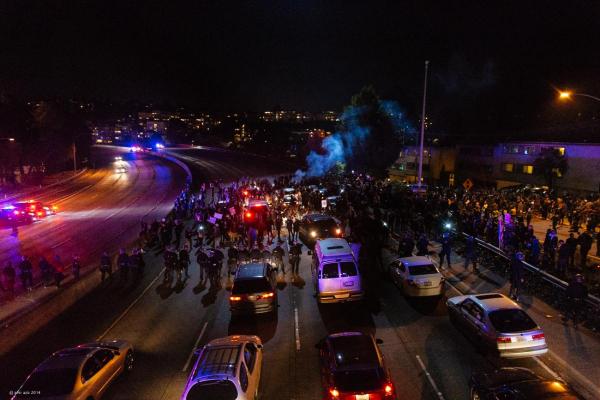I’ve been thinking about confrontational activist strategies lately, and when they do and don’t work. In a previous post, I discussed some ways that confrontation doesn’t work. Here I want to explore the ways that confrontation can succeed.
In the previous post, I cited a civil rights dispute in a North Carolina diner. For a contrast, look back 65 years to the sit-ins at diner counters in Greensboro, North Carolina. Sit-ins are certainly confrontational, far more so than legal threats under the Civil Rights Act. At the time, merely sitting at a counter and ordering a meal was seen as an act of aggression, and a crime, if you happened to be of the “wrong” skin tone. Thousands of people were arrested for violating segregation policies. By facing arrest and threats of violence by the simple act of ordering a meal in violation of the policies, the protesters forced observers to confront the immorality at the heart of the policy. So long as everyone abided by the absurdity of segregation, it seemed natural. But once it was taken to its necessary extreme, protesters (in the words of Martin Luther King Jr.’s "Letter from a Birmingham Jail", written three years later), “create[d] such a crisis and foster such a tension that a community which has constantly refused to negotiate is forced to confront the issue.” Watching those scenes forced the community to consider what it would be like to face such punishment for such trivial acts. It cast the entire Jim Crow system in a new light, led the diners’ owners to change their policies, and set the stage for federal civil rights legislation. As Dr. King wrote about similar protests three years later, the direct action was necessary because “the city’s white power structure left the Negro community with no alternative.” Without a legal avenue for change, direct action was the only path forward.
 Protesters block traffic on Interstate 580 in Oakland, November 24, 2014, chanting “Black Lives Matter” and “Hands up, don’t shoot.” Image by Amir Aziz, posted to Flickr under a CC-BY-NC-SA 2.0 license.
Protesters block traffic on Interstate 580 in Oakland, November 24, 2014, chanting “Black Lives Matter” and “Hands up, don’t shoot.” Image by Amir Aziz, posted to Flickr under a CC-BY-NC-SA 2.0 license.I think a similar analysis applies to the highway shutdowns conducted by protesters against police violence (a tactic originating here in Oakland but spreading all over). Some of those protests also led to outbreaks of violence against businesses (including a series of smashed windows near NCSE’s offices). I can’t sympathize with those who damaged these locally-owned businesses. (The shop owners probably deplore police violence themselves, and the destruction of property was perpetrated by a small cadre who don’t represent the protest but came to dominate the protest’s coverage). The highway shutdowns are a different matter, though, as was the related BART subway shutdowns the day after Thanksgiving and on Martin Luther King Day. These were incredibly disruptive, probably costing more and disturbing more lives than a smashed window or looted store. (For more on the genesis of these protests, see this interview with Alicia Garza and Patrisse Cullors in Grist.) But they also highlight a central crisis, and force people to confront the genuine problems facing minority communities in modern America.
As I mentioned before, such confrontation has very real downsides, and there’s lots of opportunity for it to backfire. There’s a reason that, in a webinar I did last year about how to confront attacks on science education, I emphasized the importance of not leading off with legal threats (or the implicit threat of citing the law, rather than the underlying principle). My training and experience here at NCSE has reinforced the idea that you can always escalate a conflict, but once you bring in legal threats or other aggressive confrontation, people are less likely to compromise, and less willing to work collaboratively. Phil Plait made a related point in his fabulous “Don’t be a dick” talk at skeptic-oriented The Amaz!ng Meeting in 2010.
Even in sparking confrontation, empathy is crucial. One of the great barriers to confronting police violence is its selective nature: as a white man, I can wear a hoodie and walk anywhere, even carrying a cosplay weapon, and not fear being gunned down by those sworn to serve and protect. But my African American neighbors learned from an early age that their every move must be cautious and calculated to avoid harassment or worse from the police. That experience is so far from my own that it's nearly impossible for me to truly empathize (however sympathetic I am).
Shutting down highways and BART forces people to think about the experiences of others, to think about how much time and effort our neighbors and colleagues must invest in avoiding a threat that we can blithely ignore. It reminds those of us who benefit from this inequity just how different our lives would be if we were treated the way minorities are treated in many of our towns and cities. While it may not inspire those drivers to join the protest, it forces them to empathize, to feel what the protesters feel. And it resonated with the core message: that black lives matter, and that their destruction was being ignored. As Patrisse Cullors told Grist (about the “Black Lives Matter” slogan, and the BART shutdown), “We were proclaiming that black lives matter no matter who you are, no matter what you are, no matter what you think.” If the problem is that people are inured to violence against our black brothers and sisters, a tactic that forces them to think about that destruction is inherently a success.
The same applies to confrontational (and cheeky) holiday displays like those put up by Satanists and Seinfeld fans across the country. These may offend some Christians, those who want manger scenes or Christmas trees in public spaces. But of course, that’s exactly the point. These Christians feel their beliefs are being dismissed or even trivialized by other people—which is exactly how non-Christians and Christian secularists feel about religious displays in public venues. By inducing that empathy (however unsympathetic), activists help people feel the threat of theocracy themselves. It may not be fun for the targets, but it moves them toward a solution that makes everyone feel better. And the same can work with protests on behalf of evolution education (the Flying Spaghetti Monster is a good example, when used well).
In the end, I think NCSE’s strategy of avoiding confrontation when possible holds up to scrutiny. Confrontational tactics are risky, often inappropriate, and really only belong on the table if they align with the core message, and if they tend to promote (and grow out of) empathy. There are usually much better ways to accomplish those ends, and trying those paths first never takes direct action off the table.

